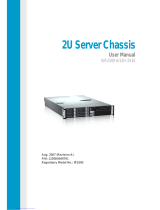
Warning Messages
A warning message alerts you to a possible problem and prompts you to respond before the system continues a task. For example, before you format a hard
PCIe Training Error: Integrated device
The specified PCIe device is faulty or
improperly installed.
For a SAS controller daughter card, reseat the card in the
dedicated PCIe connector. See Installing a SAS Controller
Daughter Card. If the problem persists, see Getting Help.
PCIeTrainingError:Slotn
Faulty or improperly installed PCIe card in the
specified slot.
Reseat the PCIe card in the specified slot number. See
Expansion Cards. If the problem persists, see Getting Help.
Plug & Play Configuration Error
Error encountered in initializing PCIe device;
faulty system board.
Install the NVRAM_CLR jumper and reboot the system. See
Figure6-1 for jumper location. If the problem persists, see
Troubleshooting Expansion Cards.
Read fault
Requested sector not found
The operating system cannot read from the
hard drive or USB device, the system could not
find a particular sector on the disk, or the
requested sector is defective.
Replace the USB medium or device. Ensure that the USB or
hard drive cables are properly connected. See Troubleshooting
a USB Device, or Troubleshooting a Hard Drive for the
appropriate drive(s) installed in your system.
Remote Access Controller cable error or
incorrect card in the RAC slot.
RAC cables not connected, or RAC card
installed in wrong expansion slot.
Check that the RAC cables are connected, and that the RAC
card is installed in the correct expansion slot. See Installing a
RAC Card.
Remote configuration update attempt
failed
System unable to process Remote
Configuration request
Retry Remote Configuration.
ROM bad checksum = address
Expansion card improperly installed or faulty.
Reseat the expansion card(s). Ensure that all appropriate
cables are securely connected to the expansion card(s). If the
problem persists, see Troubleshooting Expansion Cards.
Sector not found
Seek error
Seek operation failed
Faulty hard drive, USB device, or. USB medium.
See Troubleshooting a USB Device or Troubleshooting a Hard
Drive for the appropriate drive(s) installed in your system.
See Troubleshooting System Memory.
The amount of system memory has changed
Memory has been added or removed or a
memory module may be faulty.
If memory has been added or removed, this message is
informative and can be ignored. If memory has not been added
or removed, check the SEL to determine if single-bit or multi-bit
errors were detected and replace the faulty memory module.
See Troubleshooting System Memory.
This system supports only Opteron(TM)
2000 series processors.
Microprocessor(s) is not supported by the
system.
Install a supported microprocessor or microprocessor
combination. See Installing a Processor.
Time-of-day clock stopped
Faulty battery or faulty chip.
See Troubleshooting the System Battery.
Time-of-day not set - please run SETUP
program
Incorrect Time or Date settings; faulty system
battery.
Check the Time and Date settings. See Using the System
Setup Program. If the problem persists, replace the system
battery. See System Battery.
Timer chip counter 2 failed
Unsupported CPU combination
Unsupported CPU stepping detected
Microprocessor(s) is not supported by the
system.
Install a supported microprocessor or microprocessor
combination. See Processors.
A Trusted Platform Module (TPM) function has
failed.
Utility partition not available
The <F10> key was pressed during POST, but
no utility partition exists on the boot hard
drive.
Create a utility partition on the boot hard drive. See the CDs
that came with your system.
Warning: Following faulty DIMMs are
disabled:
DIMM n1 n2
Total memory size is reduced.
Faulty or improperly seated memory module(s).
DIMMs are disabled in pairs, as indicated by
the n1 and n2. Check both DIMMs for a
possible fault.
See Troubleshooting System Memory.
Warning: A fatal error has caused
system reset! Please check the system
event log!
A fatal system error occurred and caused the
system to reboot.
Check the SEL for information that was logged during the
error. See the applicable troubleshooting section in
Troubleshooting Your System for any faulty components
specified in the SEL.
Warning! No micro code update loaded
for processor n
Micro code update failed.
Update the BIOS firmware. See Getting Help.
Warning: One or more faulty DIMMs found
on CPUn
Faulty or improperly seated memory module(s)
used by CPUn.
See Troubleshooting System Memory.
Warning: The installed memory
configuration is not optimal. For more
information on valid memory
configurations, please see the system
documentation on the technical support
web site.
Invalid memory configuration. The system will
run but with reduced functionality.
Ensure that the memory modules are installed in a valid
configuration. See General Memory Module Installation
Guidelines. If the problem persists, see Troubleshooting
System Memory.
Write fault
Write fault on selected drive
Faulty USB device, USB medium, optical drive
assembly, hard drive, or hard-drive subsystem.
See Troubleshooting a USB Device, Troubleshooting an SD
Card or Internal USB Key, and Troubleshooting a Hard Drive.
NOTE: For the full name of an abbreviation or acronym used in this table, see the Glossary.





















